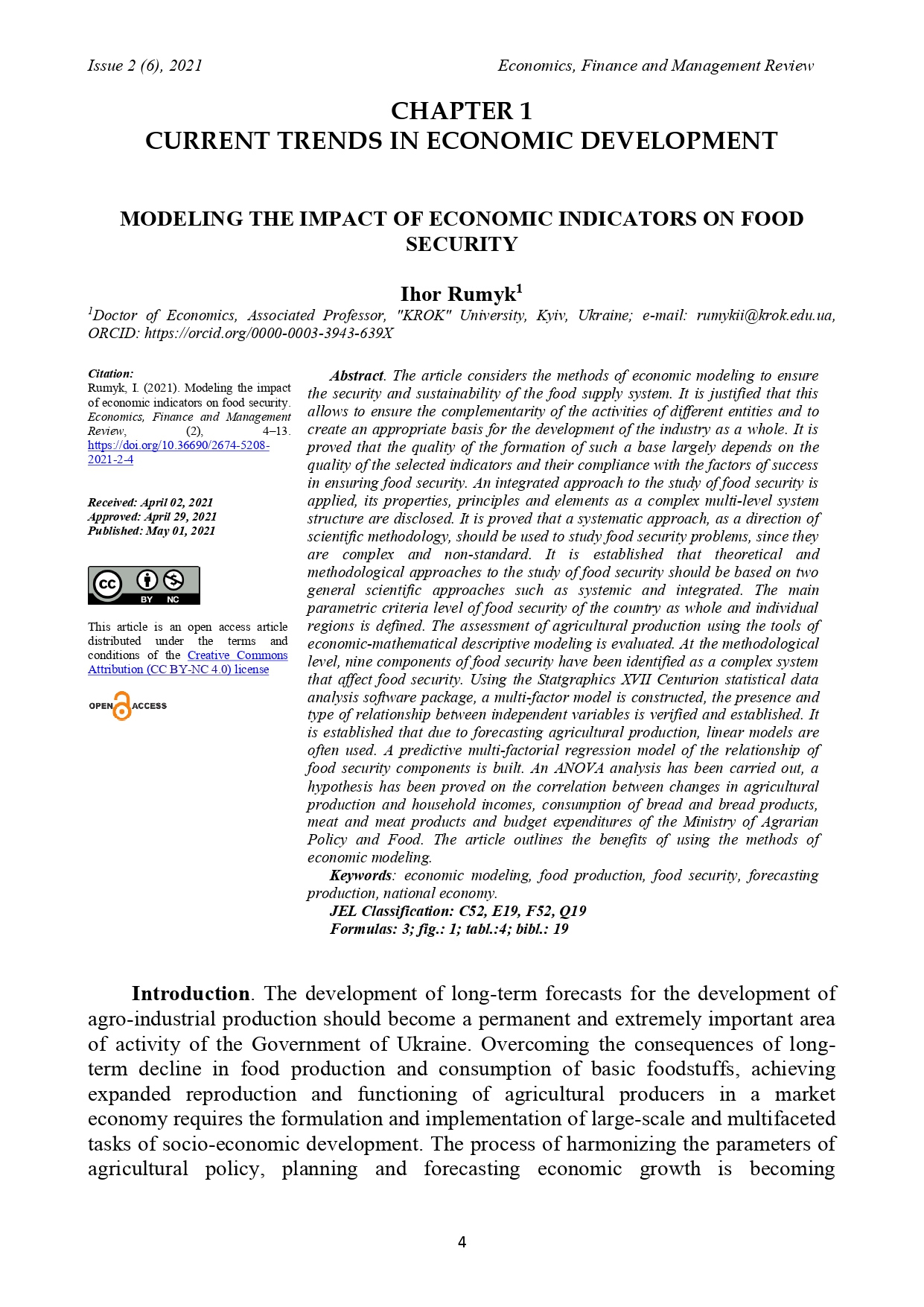MODELING THE IMPACT OF ECONOMIC INDICATORS ON FOOD SECURITY
DOI:
https://doi.org/10.36690/2674-5208-2021-2-4Keywords:
economic modeling, food production, food security, forecasting production, national economyAbstract
The article considers the methods of economic modeling to ensure the security and sustainability of the food supply system. It is justified that this allows to ensure the complementarity of the activities of different entities and to create an appropriate basis for the development of the industry as a whole. It is proved that the quality of the formation of such a base largely depends on the quality of the selected indicators and their compliance with the factors of success in ensuring food security. An integrated approach to the study of food security is applied, its properties, principles and elements as a complex multi-level system structure are disclosed. It is proved that a systematic approach, as a direction of scientific methodology, should be used to study food security problems, since they are complex and non-standard. It is established that theoretical and methodological approaches to the study of food security should be based on two general scientific approaches such as systemic and integrated. The main parametric criteria level of food security of the country as whole and individual regions is defined. The assessment of agricultural production using the tools of economic-mathematical descriptive modeling is evaluated. At the methodological level, nine components of food security have been identified as a complex system that affect food security. Using the Statgraphics XVII Centurion statistical data analysis software package, a multi-factor model is constructed, the presence and type of relationship between independent variables is verified and established. It is established that due to forecasting agricultural production, linear models are often used. A predictive multi-factorial regression model of the relationship of food security components is built. An ANOVA analysis has been carried out, a hypothesis has been proved on the correlation between changes in agricultural production and household incomes, consumption of bread and bread products, meat and meat products and budget expenditures of the Ministry of Agrarian Policy and Food. The article outlines the benefits of using the methods of economic modeling.
Downloads
References
Rumyk, Ih. Methods for evaluating models of long-term forecasting of agricultural producers. Development of the agro-food market in the conditions of globalization of economy: materials of the II All-Ukrainian scientific and practical conference (Poltava, March 31, 2020). Poltava: Department of Economics and International Economic Relations PDAA, 2020. Pp. 108-112 [in Ukrainian].
Michael, D., Bodkin, Ronald, G., Hsiao, Cheng. (1996). Econometric models, techniques, and applications. London Prentice-Hall International, Inc.
Jeffrey, M. Wooldridge. (1996). Estimating systems of equations with different instruments for different equations. Journal of Econometrics. #74. Pp. 387-405.
Brayton, F., Levin, A., Tryon, R., Willians, John C. The Evolution of Macro Models at the Federal Reserve Board. URL: http://www.federalreserve.gov/Pubs/feds/1997/199729/199729pap.pdf.
Hall, S.G. (1995). Macroeconomic and a Bit More Reality. Economic Journal. #105. Pр. 974-988.
Sims, C. (1980). Macroeconomic and Reality. Econometrica. #48. Pp. 1-48.
Lucas, R.E. (1976). Econometric Policy Evaluation: a Critique. Carnegie-Rochester Series on Public Policy. #1. Pp. 19-46.
Axelrod, R. (1976). The Structure of Decision: Cognitive Maps of Political Elites. Princeton. University Press. 404 р.
Roberts, FS. (1976). Discrete mathematical models with applications to social, biological and environmental problems. Prentice-Hall, Englewood Cliffs. N.J.
Atkin, R. and Casti, JL. (1977). Polyhedral Dynamics and the Geometry of Systems. IIASA Research Report. IIASA, Laxenburg, Austria: RR-77-006.
Zaika, V.I., Zihunov, O.M., Kyshenko, V.D. (2014). Cognitive modeling of behavior dynamic technological processes sugar juice production. Avtomatyzatsiia tekhnolohichnykh i biznes-protsesiv. Vol. 4. #6. Pp. 78-84 [in Ukrainian].
Kyzym, M.O., Pylypenko, A.A., Zinchenko, V.A. (2007). Balanced Scorecard: Monohrafiia. Kharkiv: VD «Inzhek». 192 p. [in Ukrainian].
Tkachenko, O. (2019). Cognitive Modeling of Composite Systems. Tsyfrova platforma: informatsiini tekhnolohii v sotsiokulturnii sferi. Vol. 2. #1. Pp. 11-19 [in Ukrainian].
Rumyk, Ih. (2014). Conceptual aspects of food security as a component of national security of Ukraine. Scientific notes of KROK University. Vol. 35. Kyiv. Pp. 22-32 [in Ukrainian].
Yaldin, I.V. (2011).Cognitive modeling in the forecast of strategy scenarios of steady development of business integrated structure. Problemy ekonomiky. #4. Pp.142-150 [in Ukrainian].
Garbowski, M., Lubenchenko, O., Perederii, N., Moskalenko, N., Rumyk, I. (2019). Economic and mathematical modeling of loan risks for credit unions. Journal of Management Information and Decision Sciences. Vol. 22. Issue 4. Pр. 495-500.
Bakhrushin, VE. (2011). Methods of data analysis: textbook. Guide for students. Zaporozhye: CPU. 268 p. [in Ukrainian].
Lupenko, Yu.O. (2018). Modeling of socio-economic relations in the process of scientific research. Economics of agro-industrial complex. #2. Pp. 5-13 [in Ukrainian].
Rumyk, II. (2020). Food security of the state: questions of theory, methodology and practice: monograph. Kyiv: University of Economics and Law "KROK", 420 p. [in Ukrainian].

Downloads
Published
How to Cite
Issue
Section
License

This work is licensed under a Creative Commons Attribution-NonCommercial 4.0 International License.








